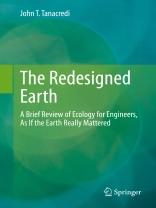This book provides insight into the basic aspects of ecology that impact or are affected by engineering practices. Ecological principals are described and discussed through the lens of the influences that built structures have on the Earth’s biological, geological, and chemical systems. The text goes on to elucidate the engineering influences that have or will influence the face of the Earth. These influences redesign the Earth, either by destroying natural systems and replacing them with highly subsidized systems or by attempting to restore highly disturbed or contaminated systems with the basic natural systems that were originally present.
Spis treści
Ecology: Principles of Life: It’s Not Just About You, You Know!.- Preserving Biological Diversity: Engineers Need An Earth Ethic Also!.- Ecotoxicology: Chickens Have Lips Don’t They?.- Genetic Engineering: Don’t Dust off the Slide Ruler Just Yet.- Sanitary Microbiology: Engineering Public Health Better Than the ‘Good Ol’ Days!’.- Marine and Estuarine Ecology-Our Oceans as the Last Frontier on Earth!.- Terrestrial Ecology-Restoration Is the Only Answer.- Limnological Systems-Dam Dams!.- Ecological Risk Assessment: Gordian Knots Untied.- Environmental Law: The Only Good Lawyer is a ____.- Coastal Ecosystem Restoration: Pride and Practice with No Follow-up!- Case Studies: Can we learn from past experiences? Or, Win Some, Loose Some, In the End there is No Free Lunch!.- Case Study 1. Laughing Gulls and Airports: “They Shoot Gulls, Don’t They?”.- Case Study 2. Bridges – Delaware Bridge Toll Authority and North Channel Bridge Jamaica Bay: Troubled Bridges Over Water.- Case Study3. Gowanus Canal Restoration: Pig Skin Purse with a Silk Lining.- Case Study 4. Sandy Hook Restoration- Beach Replenishment (Coastal Erosion and Recreation!).- Case Study 5. Vandalia Dunes and Estates – Inner City Sprawl and We Love It!.
O autorze
Scholar, Explorer, Scientist Dr. John T. Tanacredi is widely recognized as one of the foremost specialists in conservation biology of island and coastal ecology. His stellar career anchored in fieldwork spans from his serving as a flight meteorologist “Hurricane Hunter” with the US Navy, an environmental impact analyst with the US Coast Guard, a research ecologist and one of the first eco-toxicologists with the National Park Service, and a global authority on the conservation of Horseshoe Crabs.
He has held Research Associate positions at the American Museum of Natural History, Department of Invertebrate Zoology; Lamont Doherty Earth Observatory of Columbia University (Visiting Scientist National Park Service), the Chair of the Environmental Committee at the New York Academy of Sciences and continues today as Conservation Committee Co-Chair for the Explorer’s Club.
Dr. Tanacredi has written extensively on a diverse range of conservation issues and has authored 6 books and over 60 peer reviewed scientific publications. He is a pioneer in biodiversity research efforts on Easter Island and has been honored with the discovery of a new species being named after him found on Easter Island (Cryptopontius tanacredii). His 26 years as a supervisory research scientist with the National Park Service has been perpetuated after his retirement with his academic accomplishments at Molloy College in creating the CERCOM Field Station for students in the Earth and Environmental Sciences as serving as the director of CERCOM for over 19 years.
Dr. Tanacredi is one of the founding members of the IUCN-SSG for Horseshoe Crabs and principle coordinator of the 1st International Conference on Horseshoe Crab Conservation and Biology held in 2007. Dr. Sylvia Earle has recently coined him the “Horseshoe Crab Whisperer” for fostering conservation of all Horseshoe Crabs species and their habitat on a global scale. He has continued his Long Island Horseshoe Crab Habitat Inventory of some 115 locations on Long Island tracking Horseshoe Crab breeding conditions and habitat. He has initiated at CERCOM/ Molloy College several cooperative, long-term agreements with Federal and State governments, local/NGO’s and several colleges and universities from around the world. Research activities include captive breeding techniques for aqua-cultured Horseshoe Crabs and monitoring estuarine ecosystem health.
He has been interviewed by NY Times, New Yorker Magazine, Huffington Post, Newsday, Scientific American, National Geographic, and a host of local Long Island traditional and social media outlets.












